Celebrating
125 Years by Gary Minich |
||||||
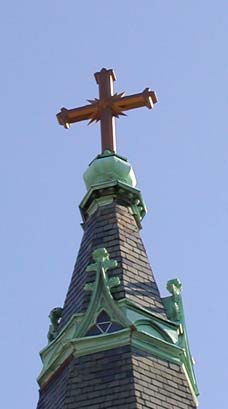
The steeple on top of the church was replaced in 2000 after high wind gusts broke part of it off.
After 125 years, St. James Roman Catholic Church of Decatur finds itself with a strong and growing congregation, a clear mission and clear hope for the future.
Currently led by Sister Glenda Bourgeois, O.S.U., named Parish Life Coordinator in 1997, St. James initiated a roof repair and interior remodeling program in 1999 that will total more than $850,000 when all the work, including outside window repairs, is completed. St. James's seventh pastor, the Rev. Martin B. Mangan, died in September 2001, just over a year after the church had been remodeled. Father Mangan, much admired in the Decatur community for support of social justice, was in semi-retirement at St. James after 40 years service to the diocese, including pastorates in Taylorville, Highland, Mt. Sterling and Tuscola.
Following Father Mangan's death, the church spent several months without an assigned priest. Retired Bishop Daniel Ryan was prominent among those who helped fill the pulpit for weekend Masses. In February 2002, the Rev. Thom Dennis, a Taylorville native, joined St. James as sacramental minister.
Since its beginning 125 years ago, St. James has been engaged in continuous building and rebuilding. Its first pastor, Father Joseph Spaeth, not only built a church and started a school during his brief two years in Decatur, but was instrumental in founding St. Mary's Hospital, located next door to St. James until the 1950s. Over the years, the parish built schools, convents, rectories, and two churches. The parish was often in debt, but was never short of faith or faithful.
St. James continues to be a strong and growing faith community. Our Rites of Christian Initiation program has added dozens of converts to the church's registry and many families that moved to the suburbs or neighboring communities continue to drive into the city to retain their ties to St. James. But St. James never had parish boundaries to start with. German immigrants, who had difficulty with English and found in the Irish St. Patrick's Church a culture different from that of their homeland, began talking about starting a second Catholic church in the early 1870's. A religious corporation was chartered in 1872, titled St. James Roman Catholic Church and Congregation. It would be another five years before the first church building appeared on East Clay Street, but the foundations for the German Catholic Church were laid.

The first St. James Church was built at 752 East Clay Street. It was complete and dedicated on New Year's Day in 1878.
In October 1872, the St. James group purchased Lot 5 of Martin's Addition of Outlots from W. Corwin Johns for $800. Three years later, a German priest - the Rev. Bernard Fresenborg - was sent to Decatur to determine whether the time was ripe to proceed with the new parish. Fresenborg stayed several weeks, long enough to baptize three infants, but he told the bishop there was not yet enough need for another Decatur church.
In 1877, Bishop Peter J. Baltes of Alton sent a newly ordained priest, the Rev. Joseph Spaeth, to Decatur to establish a church for the 16 German families that wanted it. Born in Wurtemberg, Germany, in 1851, Father Spaeth spoke their language and was sympathetic to their desire not only to worship in the mother tongue, but to have their children educated in German. He prevailed on his younger brother Anton to be the parish's first schoolmaster without compensation except for room and board. Spaeth stayed at St. James for only two short years, but they were busy ones. Besides constructing a school and starting a school, he also found time to help organize the new St. Mary's Hospital and was largely responsible for the fund drive that allowed St. Mary's to begin accepting patients in 1878. By the time Father Spaeth was reassigned in 1879, the church numbered 50 families and nearly 70 pupils were enrolled in the school.
The Rev. Louis W. Lammert, a native Westphalia, Germany, was St. James second pastor. He had been ordained in 1876 in Alton and had served at St. Joseph's Church in Cairo before coming to Decatur. He continued the building program begun by Father Spaeth, adding a parsonage in 1883 and a new two-room school in 1889. After 17 years at St. James, Father Lammert was moved to St. Anthony's in Effingham, where he served until his death in 1929.
Because St. James was organized for German-speaking Catholics, it was designated a national church, without parish boundaries. This meant Decatur Catholics could choose either the Irish church or the German church, no matter where they lived in the community. The 1880s saw an expansion of coal mining in the area and an influx of German and Polish miners, who helped swell St. James's pews. Various organizations were formed among the laity, including the German Catholic Vereinsbund for men, the German Aid Society, St. Agnes Sodality for girls, St. Aloysius Society for boys, and the St. Elizabeth Sodality for women. St. Elizabeth's continues at St. James, 121 years after its founding.
A third German-born priest followed Father Lammert. The Rev. Aloysius Teppe, a 42-year-old native of Bavaria, came to St. James from Morrisonville in 1896 and added a large two-story addition to the white frame school built by Lammert. He also obtained three School Sisters of St. Francis to serve the 113 students.
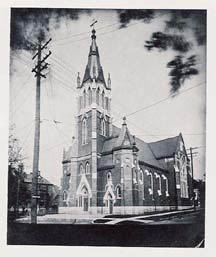
In 1912, the new constructed church was completed. The church was formally dedicated on June 23, 1912.
By 1906, St. James's congregation had grown to 125 families and there was serious talk about the need for a new church building. In October 1908, men of the parish met and raised more than $20,000 for the project. It took another two years for building plans to be approved at a general meeting of the congregation.
George P. Stauduhar, a Rock Island architect who specialized in Catholic church construction, including the new St. Patrick's Church in Decatur, designed a German Gothic structure for St. James. The external supporting buttresses, ribbed vaults and pointed arches reflected a style that had been popular in Europe for nearly 700 years. Specifications called for it to be built of Decatur vitrified brick on a white stone foundation. The exterior trim was terra cotta molded into gothic scrolls.
On March 4, 1911, a $52,000 general contract for the building was awarded to Polson Brothers of Chicago. Subcontracts for the altars and organ, the stained glass windows, plumbing, heating and electrical wiring added $23,000 to the construction costs. Building began shortly after the cornerstone was laid on June 11.
Poor health forced Father Teppe to give up his pastorate in August 1911, but he stayed on at the rectory, serving as chaplain for St. Mary's Hospital, until his death in 1927.
Rev. Francis J. Ostendorf, a 35-year-old native of Effingham, replaced Teppe and formally dedicated the new church on June 23, 1912. Father Spaeth, by then only 10 months from his death in 1913, celebrated the final mass in the old building at 7:30 a.m. Then, at 10 a.m., Bishop James Ryan blessed and dedicated the new building which was filled to its 500-seat capacity. The centerpiece of the new church was its magnificent 34-foot high altar, hand-carved from basswood and designed especially for St. James.
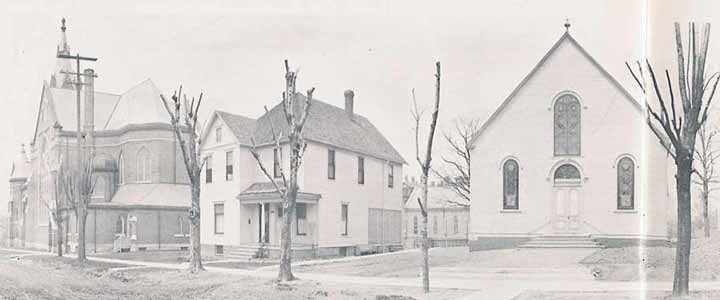
A view of St. James Parish in 1912 down Clay Street..
Above: The new Church, the convent (where the current rectory is) and parish hall (old church)
Below: The first rectory and the school going east towards Maffit Street.
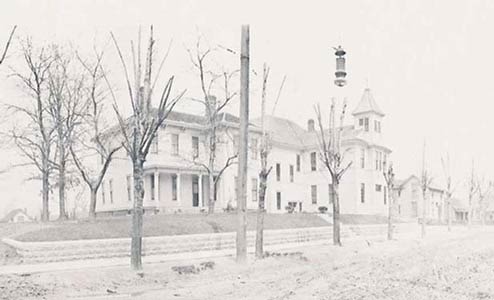
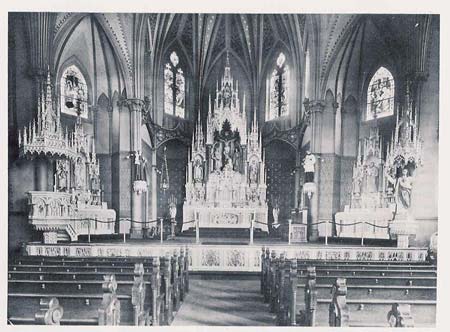
A view of the sanctuary in 1912. Note the carved altar rail which extended the width of the chancel separating it from the nave.
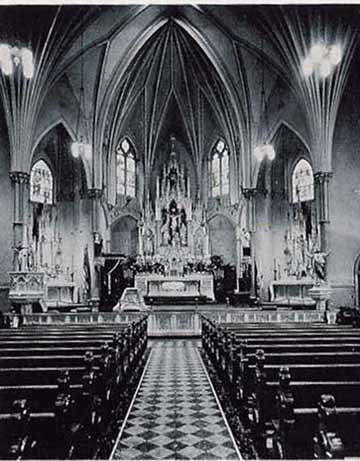
St. James in 1949 after it had been redecorated.
In 1948, the 36-year-old church was redecorated for Father Ostendorf's Golden Jubilee celebration. On June 9, 1949, the veteran priest was honored by both diocesan clergy and laity and was given a new Packard automobile and a substantial cash gift. The new rectory was constructed in 1950-51 at a cost of $125,000, with $95,000 raised by the congregation. After 41-years service to St. James, Father Ostendorf died on Sept. 1, 1952, and was buried in his hometown, Newton.
Father Frederick W. Klasner, who had served as an assistant pastor at St. James from 1922 to 1937, returned to the church after Ostendorf's death and stayed until 1970, when failing health led him to resign. He was succeeded by Father Edward D. Adamski, a native of Chicago.
Father Adamski resurrected the Thursday Nite Parties both to retire that debt and to raise funds for needed repairs to the church and school. In the late 1970s, he oversaw an interior remodeling that both reflected the liturgical changes resulting from the Second Vatican Council, and contemporary thinking about church styles.
When Father Mangan came to Decatur in 1991, St. James was the smallest of the city's five congregations. He was drawn to the parish by the challenge of finding ways to keep the school open for continued service to the now African-American neighborhood surrounding it.
Once here, he found another calling. In 1992, A.E. Staley Mfg. Co. found workers at odds with its new British owners. Father Mangan was drawn to the workers' plight, if not their cause. Two years later, when labor disputes at Staley, Caterpillar and Bridgestone-Firestone catapulted the city into international headlines, Mangan became a principal spiritual leader for all the embattled workers. The school gymnasium was dedicated in his memory in May of 2002.
In 2000, Sister Kathleen Wegman, S.S.N.D, assumed the principalship of the school, the first religious to serve the school in nearly 20 years. Although Sister Kathleen rejoined her order in Kyoto, Japan, in 2002, the Notre Dame Sisters provided a replacement, Sr. Linda Kremer, and pledged a continuing commitment to St. James School.
At age 125, St. James finds itself filled with people of faith, hope and love. The story does not end here.